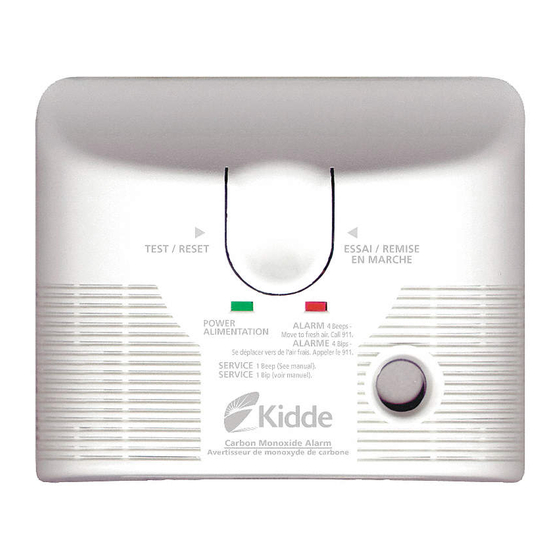
Table of Contents
Advertisement
Carbon Monoxide Alarm
User's Guide
ATTENTION: Please take a few minutes to thoroughly read this
user's guide which should be saved for future reference and
passed on to any subsequent owner.
User's Guide P/N 820-1442 Rev. B 10/12
900-0215
KN-COB-LCB-CA
with Battery Backup
AC Plug-in Operated with Battery Backup
900-0215
Advertisement
Table of Contents

Summary of Contents for Kidde 900-0215
-
Page 1: Carbon Monoxide Alarm
Carbon Monoxide Alarm User’s Guide 900-0215 900-0215 KN-COB-LCB-CA with Battery Backup AC Plug-in Operated with Battery Backup ATTENTION: Please take a few minutes to thoroughly read this user’s guide which should be saved for future reference and passed on to any subsequent owner. -
Page 2: What To Do When The Alarm Sounds
What to do When the Alarm Sounds! Carbon Monoxide Alarm Procedure WARNING: Activation of the CO Alarm indicates the presence of Carbon Monoxide (CO) which can kill you. If alarm sounds 4 quick beeps, 5 seconds off: 1) Immediately move to fresh air - outdoors or by an open door/window. -
Page 3: Important Warning Statements
Note: Many times throughout this User’s Guide, we will refer to Carbon Monoxide as “CO”. This Kidde carbon monoxide (CO) alarm is an important part of your family’s home safety plan. This alarm has been designed and tested to detect CO buildup in a residential environment. Your alarm is for use specifically in the home. - Page 4 Important Warning Statements WARNING: This product is intended for use in ordinary indoor locations of family living units. It is not designed to measure compliance with commercial or industrial standards. It is not suitable for installation in hazardous locations as defined in the National Electric Code.
-
Page 5: Information About Carbon Monoxide
1. Information About Carbon Monoxide General Carbon Monoxide Information Carbon monoxide is a colorless, odorless and tasteless poison gas that can be fatal when inhaled. CO inhibits the blood’s capacity to carry oxygen. Periodically review this user's guide and discuss your CO alarm emergency procedure with all the members of your family. - Page 6 1. Information About Carbon Monoxide Possible Sources of Carbon Monoxide Inside your home, appliances used for heating and cooking are the most likely sources of CO. Vehicles running in attached garages can also produce dangerous levels of CO. CO can be produced when burning any fossil fuel, such as gasoline, propane, natural gas, oil and wood.
- Page 7 Because carbon monoxide is a cumulative poison, long-term exposures to low levels may cause symptoms, as well as short-term exposures to high levels. This Kidde unit has a time-weighted alarm – the higher the level of CO present, the sooner the alarm will be triggered.
-
Page 8: Product Features And Specifications
CO alarm. CO alarms should not be used to detect the presence of natural gas (methane), propane, butane, or other combustible fuels. 2. Product Features and Specifications Test/Reset Button 900-0215 Sounder Alarm Direct Green Plug-In... - Page 9 2. Product Features and Specifications 900-0215 Tamper-Resist Activate Slide Tamper-Resist Activation Switch (see Normal Operating Characteristics) Screw 9 Volt Battery Door (used with Tamper-Resist Feature) Tamper-Resist Feature This is a constant 85dB alert to notify consumers the unit has been unplugged or has come loose from the outlet.
- Page 10 2. Product Features and Specifications Low Battery HUSH ® CONTROL When the battery needs to be replaced, the unit will produce a low battery warning. The Low Battery HUSH feature allows you to press the ® button on the alarm and disable the “chirp” for a random period of up to 12 hours.
-
Page 11: Installation Locations
(40°F) or hotter than 37.8°C (100°F) such as crawl spaces, attics, porches and garages. • Do not install within 5 ft. of heating or cooking appliances. (Kidde recommends 15 ft. to prevent nuisance alarms). • Do not install near vents, flues, chimneys or any forced/unforced air ventilation openings. -
Page 12: Installation Instructions
3. Installation Locations • Do not obstruct the vents located on the alarm. Do not place the alarm where drapes, furniture or other objects block the flow of air to the vents. • Do not install on a switched or dimmer-controlled outlet. 4. -
Page 13: Operating Characteristics
6. Operating Characteristics When you first power up the alarm: The alarm will sound briefly, then the green Operate LED will light. This indicates that the CO alarm is receiving power and that the alarm circuit is functioning. Within a few minutes, your carbon monoxide alarm will start monitoring for CO and will continue to do so as long as it receives power or the end of life function is activated. -
Page 14: Maintenance
7. Maintenance NOTE: This unit is sealed. The cover is not removable. Due to the loudness of the alarm, we suggest that you place your fingers over the sounder opening while testing your alarm. CAUTION: Continuous exposure to the high sound level of this alarm over an extended period of time may cause hearing loss. - Page 15 7. Maintenance Maintenance Tips To keep your alarm in good working order, you must follow these steps: • Test the alarm once a week by pressing the Test/Reset button. • Vacuum the alarm cover once a month to remove accumulated dust. •...
-
Page 16: Limited Warranty
In many cases, the quickest way to exchange your alarm is to return it to the original place of purchase. Alternatively, you may return it for servicing to Kidde. If you have questions, call Kidde Product Support at 1-800-880-6788.
















Need help?
Do you have a question about the 900-0215 and is the answer not in the manual?
Questions and answers